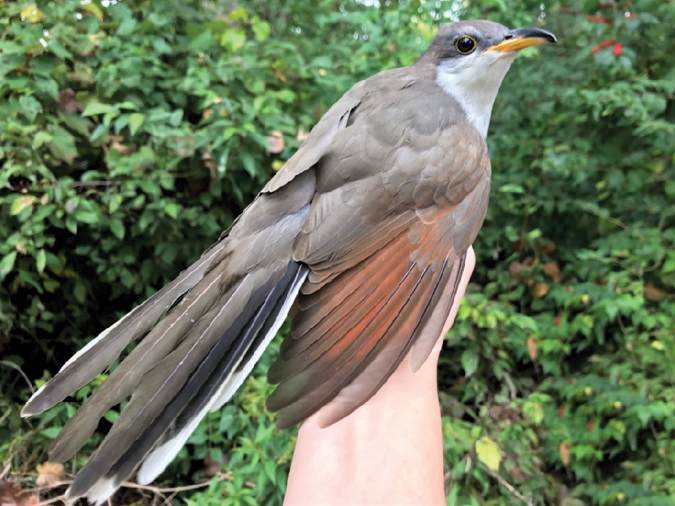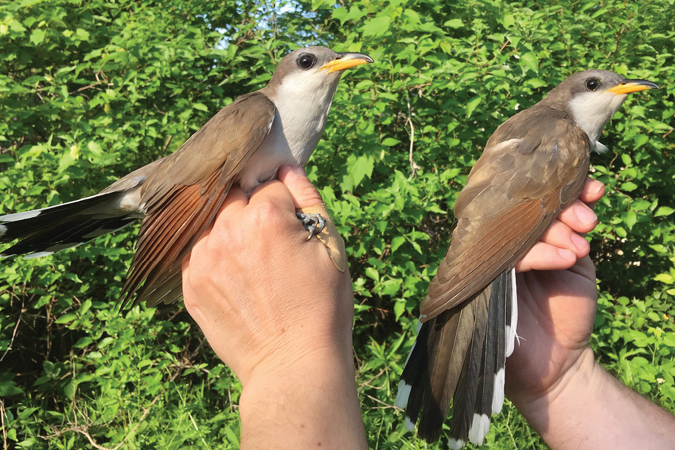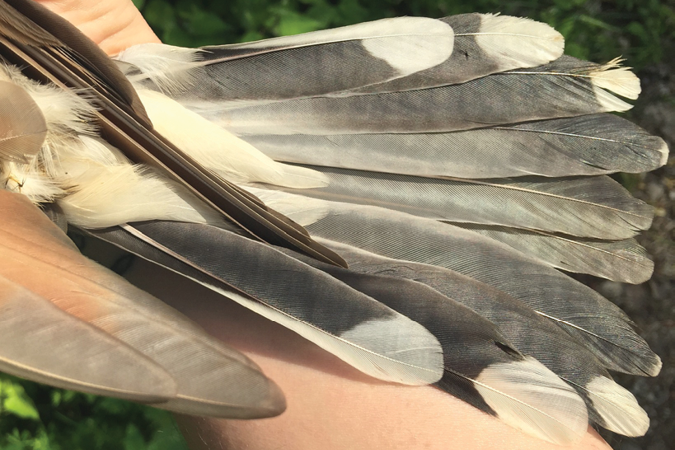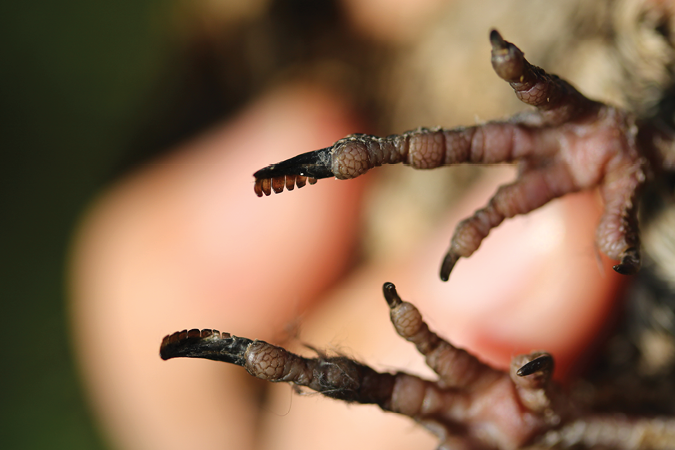Cuckoos Cuculidae
about cuckoos in nw ohio
Two species of cuckoo occur in Ohio: the Yellow-billed Cuckoo and Black-billed Cuckoo. They may winter as far south as central South America with some traveling as far north as southern Canada to breed. In Northwest Ohio in spring, cuckoos pass through primarily in the latter half of May, foraging in a variety of forests. In fall, passage is much more sporadic through the season, and the lack of encounters of Black-billed suggests a resistance to cross Lake Erie.
On occasion, cuckoos will venture down to forest undergrowth following caterpillars and other insects; however, they primarily remain in the canopy, hiding in dense foliage. Because cuckoos aren’t particularly abundant during migration, their banding totals may not truly reflect the number of birds moving through as these birds tend to stay high and their larger size may impact their capture rate. Data on cuckoo sexes are unavailable as males and females are identical in plumage and nearly so in size.
On occasion, cuckoos will venture down to forest undergrowth following caterpillars and other insects; however, they primarily remain in the canopy, hiding in dense foliage. Because cuckoos aren’t particularly abundant during migration, their banding totals may not truly reflect the number of birds moving through as these birds tend to stay high and their larger size may impact their capture rate. Data on cuckoo sexes are unavailable as males and females are identical in plumage and nearly so in size.
Yellow-billed Cuckoo Coccyzus americanus
|
Alpha Code: YBCU Spanish: Cuco de Pico Amarillo French: Coulicou à bec jaune Band Size: 2 ~ 3 NW Ohio Status: Migrant, Breeding Total Banded in Spring: 63 Average Banded in Spring: 2 Total Banded in Fall: 119 Average Banded in Fall: 4 |
Song: hollow, rattling ka-ka-ka-ka-ka-ka-kow-kow-kowp, kowp, kowp, kowp slowing down near the end
Description: Gray-brown above with white underparts. Predominantly yellow bill and dusky-yellow eyering. Large white tail tips. Rufous wings. Male and female alike throughout the year. Spring Migration Timing: Primarily third wave, with birds first appearing around the second week of May and the peak of total birds occurring May 18-30. |
Fall Migration Timing: Fairly protracted with birds moving through the region mid-August into mid-October, and the peak of total birds occurring September 7-23.
Migration Habitat: Woodlands, thickets, and groves. YBCU primarily stay hidden among dense canopy foliage but will move lower into forest edge scrub-shrub and undergrowth. |
Black-billed Cuckoo Coccyzus erythropthalmus
|
Alpha Code: BBCU Spanish: Cuco de Pico Negro French: Coulicou à bec noir Band Size: 2 ~ 3 NW Ohio Status: Migrant, Breeding-rare Total Banded in Spring: 97 Average Banded in Spring: 3 Total Banded in Fall: 7 Average Banded in Fall: <1 |
Song: series of soft cu-cu-cu-cu notes of the same pitch
Description: Gray-brown above with white underparts. Silvery-black bill. Red eyering. Small white tail tips. Male and female alike throughout the year. Spring Migration Timing: Primarily third wave, with birds first appearing in early May and peak movement occurring May 21 through June 3. |
Fall Migration Timing: Insufficient data to graph.
Migration Habitat: Woodland edges, thickets, and groves. BBCU primarily stay hidden among dense vegetation in scrub-shrub along forest edges, young trees, and marsh edges. Notes: While BBCU do breed north of NW Ohio, encounters with them during their flights south in fall are infrequent. |
Nightjars Caprimulgidae
about nightjars in nw ohio
Two species of nightjar commonly occur in Northwest Ohio, with a third, mostly southern species occasionally making its way north. These aerial insectivores forage primarily at night, dusk, and dawn, capturing moths and other insects in their wide, gaping mouths. As an active forager of the dark, nightjars are extremely well camouflaged for daytime roosting on horizontal surfaces, seamlessly blending in with rotten logs and tree branches.
Nightjars may arrive in Northwest Ohio as early as April, but primarily appear along the lake shore in early May. Due to their habitat preferences, the Eastern Whip-poor-will is the primary nightjar encountered during BSBO’s banding operations. Although a number of nightjars may be heard before sunrise, nightjar activity generally ceases before banding operations begin for the day.
Nightjars may arrive in Northwest Ohio as early as April, but primarily appear along the lake shore in early May. Due to their habitat preferences, the Eastern Whip-poor-will is the primary nightjar encountered during BSBO’s banding operations. Although a number of nightjars may be heard before sunrise, nightjar activity generally ceases before banding operations begin for the day.
Eastern Whip-poor-will Caprimulgus vociferus
|
Alpha Code: EWPW Spanish: Chotacabras Cuerporruín Norteño French: Engoulevent bois-pourri Band Size: 1D ~ 2 ~ 1A NW Ohio Status: Migrant, Breeding-local Total Banded in Spring: 30 Average Banded in Spring: 1 Total Banded in Fall: 1 Average Banded in Fall: <1 |
Song: ringing series of Whip-poor-will! often given continuously through the night
Description: Often overlooked as part of a rotting log, the bird has an overall camouflaged mottling of brown, gray, and limited rufous, with notably gray scapulars. In flight, males show white corners to the tail, while females have buff. Spring Migration Timing: A secretive migrant. Some begin to appear by mid April, but peak migration occurs from April 30 through May 7. |
Fall Migration Timing: Insufficient data to graph.
Migration Habitat: In a variety of woodlands, birds are typically found on fallen logs, low branches, or directly on the ground. Exceptional camouflage allows the bird to blend in with the surrounding habitat. Notes: Numbers may not reflect true abundance of birds as most EWPW activity (nocturnal foraging) ceases just before banding operations begin. |
Hummingbirds Trochilidae
about hummingbirds nw ohio
The Ruby-throated Hummingbird is Ohio’s only common hummingbird (with the occasional stray western species occurring rarely). These small, active birds are renowned for their bright iridescent feathers, high energy, and willingness to come to backyard feeders. Hummingbirds can be found in a variety of habitats during migration, but tend to favor areas with flowers. However, while they are famously known for consuming nectar and sugar-water, hummingbirds also feed on small insects, even plucking spiders and other captured prey from webs.
Wintering primarily in southern Mexico and Central America, the Ruby-throated arrives in Northwest Ohio as early as late April, but makes its biggest pushes in May. During fall, as flowers become scarce, hummingbirds may become thinly dispersed across the landscape, and most depart the region by October.
Wintering primarily in southern Mexico and Central America, the Ruby-throated arrives in Northwest Ohio as early as late April, but makes its biggest pushes in May. During fall, as flowers become scarce, hummingbirds may become thinly dispersed across the landscape, and most depart the region by October.
Ruby-throated Hummingbird Archilochus colubris
|
Alpha Code: RTHU Spanish: Colibrí Garganta Rubí French: Colibri à gorge rubis Band Size: X NW Ohio Status: Migrant, Breeding Total Banded in Spring: 1,329 Average Banded in Spring: 53 Total Banded in Fall: 352 Average Banded in Fall: 12 |
Song: series of repetitive chips; calls include twittering squeaks
Spring Description: Iridescent green above with white underparts. Male with iridescent ruby throat (gorget). Female with white throat, sometimes with dusky markings. Spring Migration Timing: Second into third wave, with males arriving in the region within the first week of May and the peak of total birds occurring May 15-25. |
Fall Description: Adult birds same as spring. Young female same as adult female. Young male with dusky throat markings or a limited number of ruby gorget feathers.
Fall Migration Timing: Early, with the heaviest movements confined to September and most birds departing by October. Peak movement of total birds occurring August 31 through September 17. Migration Habitat: Semi-open areas and forest edges where flowers are present including forest clearings, scrub-shrub, urban parks, and backyards. Notes: Probably some level of under-representation in data as research project is designed for larger songbirds and RTHU may pass through nets without being captured. With their slightly smaller size, males may pass through more frequently than females (possibly explaining their much lower numbers). |

























